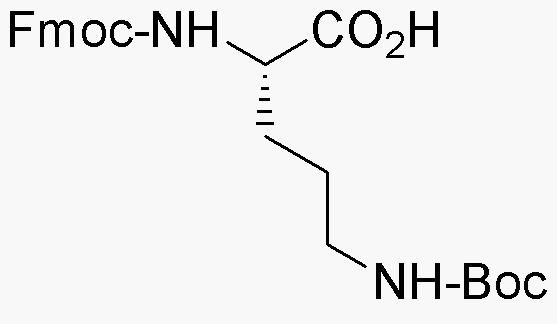Na-Fmoc-Nd-Boc-L-ornithine is widely utilized in research focused on:
- Peptide Synthesis: This compound serves as a key building block in the synthesis of peptides, particularly in solid-phase peptide synthesis, allowing researchers to create complex peptide structures efficiently.
- Drug Development: Its unique structure aids in the design of peptide-based drugs, enhancing the bioactivity and stability of therapeutic agents, which is crucial in pharmaceutical research.
- Bioconjugation: The compound is used in bioconjugation techniques, linking biomolecules to drugs or imaging agents, which is essential for targeted therapy and diagnostics in medicine.
- Research in Neuroscience: It plays a role in studying neurotransmitter systems, helping researchers understand neuropeptide functions and their implications in neurological disorders.
- Protein Engineering: The compound is valuable in the modification of proteins, enabling the development of novel protein functions and enhancing their therapeutic potential.
General Information
Properties
Safety and Regulations
Applications
Na-Fmoc-Nd-Boc-L-ornithine is widely utilized in research focused on:
- Peptide Synthesis: This compound serves as a key building block in the synthesis of peptides, particularly in solid-phase peptide synthesis, allowing researchers to create complex peptide structures efficiently.
- Drug Development: Its unique structure aids in the design of peptide-based drugs, enhancing the bioactivity and stability of therapeutic agents, which is crucial in pharmaceutical research.
- Bioconjugation: The compound is used in bioconjugation techniques, linking biomolecules to drugs or imaging agents, which is essential for targeted therapy and diagnostics in medicine.
- Research in Neuroscience: It plays a role in studying neurotransmitter systems, helping researchers understand neuropeptide functions and their implications in neurological disorders.
- Protein Engineering: The compound is valuable in the modification of proteins, enabling the development of novel protein functions and enhancing their therapeutic potential.
Documents
Safety Data Sheets (SDS)
The SDS provides comprehensive safety information on handling, storage, and disposal of the product.
Product Specification (PS)
The PS provides a comprehensive breakdown of the product’s properties, including chemical composition, physical state, purity, and storage requirements. It also details acceptable quality ranges and the product's intended applications.
Certificates of Analysis (COA)
Search for Certificates of Analysis (COA) by entering the products Lot Number. Lot and Batch Numbers can be found on a product’s label following the words ‘Lot’ or ‘Batch’.
Número de catálogo
Número de lote/lote
Certificates Of Origin (COO)
This COO confirms the country where the product was manufactured, and also details the materials and components used in it and whether it is derived from natural, synthetic, or other specific sources. This certificate may be required for customs, trade, and regulatory compliance.
Número de catálogo
Número de lote/lote
Safety Data Sheets (SDS)
The SDS provides comprehensive safety information on handling, storage, and disposal of the product.
DownloadProduct Specification (PS)
The PS provides a comprehensive breakdown of the product’s properties, including chemical composition, physical state, purity, and storage requirements. It also details acceptable quality ranges and the product's intended applications.
DownloadCertificates of Analysis (COA)
Search for Certificates of Analysis (COA) by entering the products Lot Number. Lot and Batch Numbers can be found on a product’s label following the words ‘Lot’ or ‘Batch’.
Número de catálogo
Número de lote/lote
Certificates Of Origin (COO)
This COO confirms the country where the product was manufactured, and also details the materials and components used in it and whether it is derived from natural, synthetic, or other specific sources. This certificate may be required for customs, trade, and regulatory compliance.


